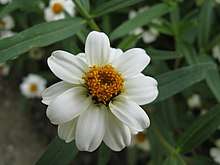Zinnia angustifolia
Zinnia angustifolia, the narrowleaf zinnia,[2] is a herbaceous flowering plant species of zinnia native to northern and western Mexico and naturalized in parts of the Southwestern United States. Hybrids between Z. angustifolia and other species of Zinnia are popular garden plants.[3]
| Zinnia angustifolia | |
|---|---|
 | |
| Zinnia angustifolia 'Star White' in flower | |
| Scientific classification | |
| Kingdom: | Plantae |
| Clade: | Tracheophytes |
| Clade: | Angiosperms |
| Clade: | Eudicots |
| Clade: | Asterids |
| Order: | Asterales |
| Family: | Asteraceae |
| Genus: | Zinnia |
| Species: | Z. angustifolia |
| Binomial name | |
| Zinnia angustifolia Kunth 1818 | |
| Synonyms[1] | |
| |
Description
Zinnia angustifolia is an annual or perennial[4] growing up to 50 cm (20 inches) tall. The stems have many branches and the herbage is rough with short hairs.[5] The 2–7 cm × 4–8 mm (0.8-2.8 × 0.16-0.32 inches)leaf blades are linear to narrowly elliptic. The heads of flowers have involucres that are mostly hemispheric (shaped like a globe that is cut in half), usually much less than 1 cm high (0.4 inches) or wide. The flowers have bright orange or sometimes yellow ray corollas,[4] but in cultivated plants, the flowers may be white or a variety of other colors.[6]
- Varieties of wild populations[1]
- Zinnia angustifolia var. angustifolia
- Zinnia angustifolia var. littoralis (B.L.Rob. & Greenm.) B.L.Turner
- Cultivars
This species has many cultivars belonging to three classes:
- The Profusion series (Zinnia angustifolia x elegans): orange, cherry, double cherry, apricot, deep apricot, coral pink, fire or white flowers.
- The Star series: orange, white or gold flowers.
- The Crystal White cultivar: with white flowers.
References
- The Plant List, Zinnia angustifolia Kunth
- "Zinnia angustifolia". Natural Resources Conservation Service PLANTS Database. USDA. Retrieved 9 August 2015.
- Joseph Tychonievich (2013). Plant Breeding for the Home Gardener: How to Create Unique Vegetables and Flowers. Timber Press. pp. 165–. ISBN 978-1-60469-364-5.
- Paul Schultz Martin (1998). Gentry's Río Mayo Plants: The Tropical Deciduous Forest & Environs of Northwest Mexico. University of Arizona Press. pp. 262–. ISBN 978-0-8165-1726-8.
- Asa Gray (1895). Field, Forest, and Garden Botany: A Simple Introduction to the Common Plants of the United States East of the 100th Meridian, Both Wild and Cultivated. American book Company. pp. 244–.
- Singh, A.K. (1 January 2006). Flower Crops: Cultivation and Management. New India Publishing. pp. 404–. ISBN 978-81-89422-35-6.